Where the candidates for California governor stand on the state’s biggest issues
Welcome to your guide to some of the key policy positions of six top candidates in California’s race for governor.
The candidates listed have met certain criteria, including: previous election to public office; at least 5% support from likely voters in an independent, established public opinion poll; or demonstrated fundraising ability.
Here’s where they stand.
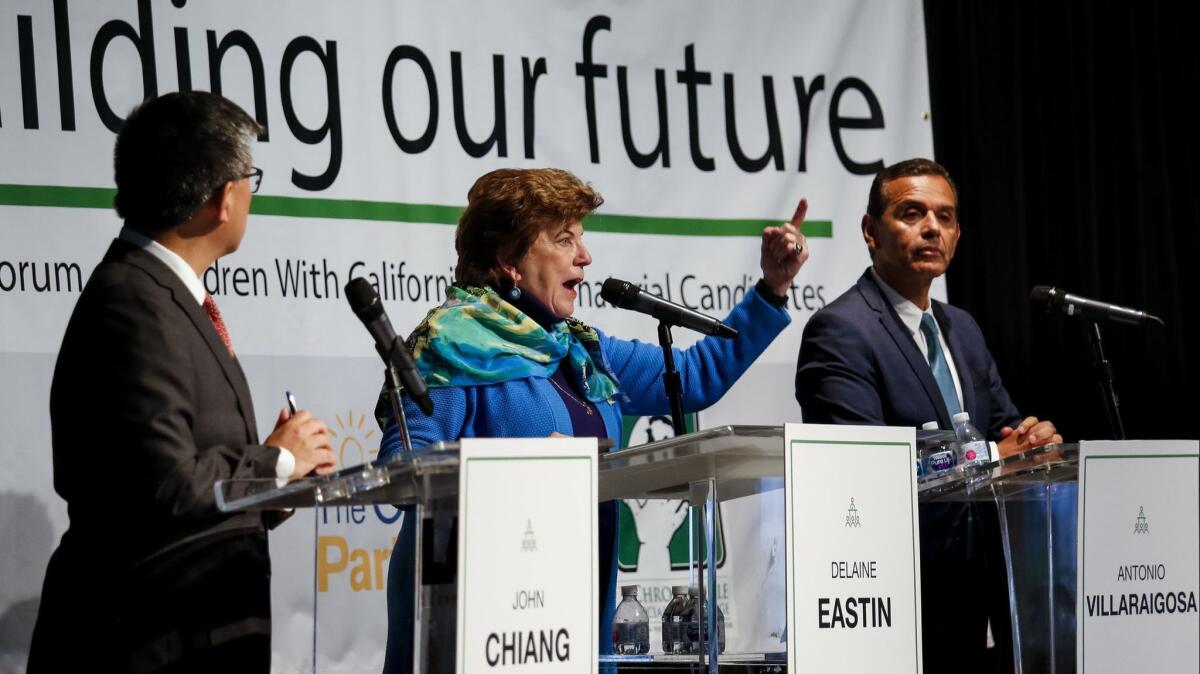
Education
Huntington Beach Assemblyman Travis Allen, Republican: Allen, a product of public schools, says on his campaign website that “California needs more charter schools and greater school choice to truly educate our children.” He wants to increase standardized testing in K-12 schools in the state to help measure teacher effectiveness.
Since his election to the Assembly in 2012, Allen has introduced legislation including bills in support of charter schools, to increase teacher accountability requirements at public schools, to loosen vaccination requirements for students and a resolution urging UC administrators to reverse tuition and fee increases. Most of Allen’s proposed legislation died in committee or was vetoed.
State Treasurer John Chiang, Democrat: Chiang says he wants to empower local communities to fund school construction and other needs by lowering the threshold for voter approval of bonds from two-thirds to 55%.
He believes offering student loan forgiveness will help boost the number of skilled teachers in the state, and wants to establish Academic Senates in public school districts “to allow teachers to share in decision-making over textbooks, curriculum, in-service training, the hiring of principals and other critical policies.”
Chiang would also make community college in the state free for two years, and has called on the UC and California State university systems to delay taking up tuition or fee increases until at least 2019.
Businessman John Cox, Republican: Cox is a proponent of vouchers for low-income students to allow families to send their children to charter or private schools. He has called for a full investigative review of the state school system to find and fix inefficiencies.
Cox has also blasted the cost of higher education in the state, and has said cost-cutting measures should include looking at professors’ course loads to ensure colleges and universities are getting the most out of their employees.
Former state schools chief Delaine Eastin, Democrat: As the state’s former superintendent of public education, Eastin has made education a central focus of her gubernatorial campaign. Eastin would work toward offering universal preschool for all children in California, and wants to expand the school year for students from 180 days to 200 days. The move, she says, would not only boost student achievement, but teacher salaries.
Of the six top gubernatorial candidates, Eastin has the most liberal plans for higher education. She has pushed for free college tuition at UC, CSU and community college campuses in the state.
Lt. Gov. Gavin Newsom, Democrat: Newsom has emphasized a campaign promise to work toward universal preschool in the state, and wants a greater focus on investing in early childhood education and care for the first three years of a child’s life. He also wants to launch college savings accounts for all incoming kindergarten students in the state.
Newsom would also guarantee two free years of community college tuition for California students, and says he would work toward reducing the cost of higher education to relieve student debt.
Former Los Angeles Mayor Antonio Villaraigosa, Democrat: Villaraigosa has also made education a central plank of his campaign platform. A proponent of charter schools, Villaraigosa’s bid for governor has been richly supported by millions of dollars from advocates of such campuses. The former L.A. mayor, who famously took on teachers’ unions while in office, would move to increase funding and access to charter schools for low-income students.
On higher education, Villaraigosa says on his campaign website that the state needs to “dramatically increase access to college and lifelong learning and make sure students can earn degrees and certificates without crushing debt.”
Live coverage of California's primary »
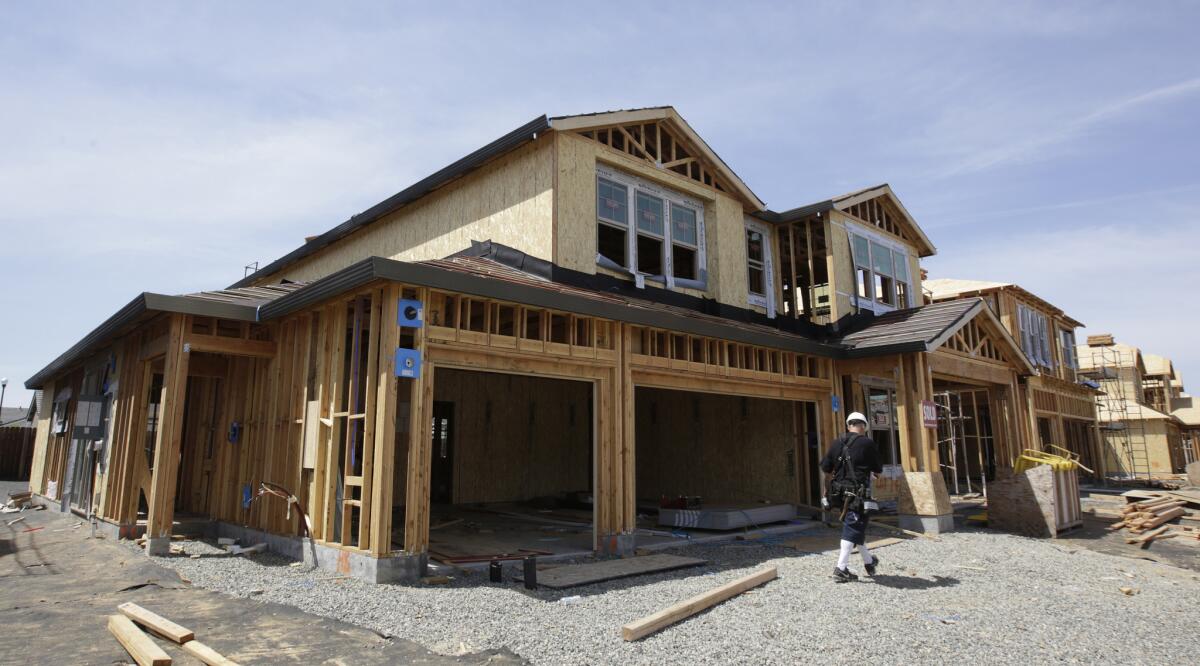
Housing and homelessness
Allen: Allen has a goal for developers to build at least 1 million new homes in his first four years as governor. He believes the state needs to strip away many of the regulations around home building, which he says would allow developers to increase the housing supply. He doesn’t support subsidizing low-income housing, arguing developers will build for people of all incomes if taxes and fees are lower.
The Huntington Beach Republican is also opposed to a potential November ballot measure to allow for the expansion of rent control. He believes rent control leads to housing shortages and says he’d work to eliminate all existing rent control policies across the state.
Allen wants to bring back state-run mental health institutions for homeless residents who need psychiatric assistance. He also wants to encourage local governments to aggressively enforce laws preventing people from sleeping on sidewalks or under bridges.
Chiang: Of all the candidates, Chiang is calling for the most government spending on housing. He would set a goal for the state to help finance 1.6 million homes for low- and moderate-income Californians from 2019 to 2030. He has also proposed a future $9-billion bond measure to subsidize new low-income construction, property tax breaks for developers who agree to set aside part of their projects for low-income families and additional tax revenue to cities that approve more housing.
Chiang is opposed to the potential rent control ballot measure, and believes that the state could change Costa-Hawkins, the law prohibiting the expansion of rent control, to allow for its broader use in certain circumstances.
Chiang argues that the best way to address homelessness is to provide a stronger safety net for the homeless and those at risk. He wants to spend hundreds of millions of dollars funding a statewide program to offer temporary cash for rental and utility bills, provide emergency vouchers for motels or hotels and assistance with moving costs.
Cox: Cox, who owns a real estate investment and property management company, has a goal for developers to build 3 million new homes over the next decade. He said that the state needs to reduce regulations on builders, including replacing its primary environmental law governing development, the California Environmental Quality Act, with a less comprehensive measure. Cox also wants to allow Californians to be able to take the property tax benefits they receive under Proposition 13 with them when they move.
Cox is against a potential November ballot measure to help rent control expansion.
On homelessness, he believes the state should rely more heavily on nonprofits and other private providers for assistance.
Eastin: Eastin would set a goal of developers building 1 million new homes in her first four years in office, and would prioritize construction around transit hubs. She wants to rezone a lot more land for housing, including current commercial properties, increasing land available for duplexes and town homes, and making it easier to build homes on smaller lots.
Of the top candidates in the race, Eastin has been the most supportive of expanding rent control as well as advocating for the repeal of the Ellis Act, which allows for the eviction of rent-controlled tenants if landlords convert their buildings to for-sale condominiums.
On homelessness, Eastin would declare a state of emergency on homelessness, which she believes would allow her to waive zoning rules for building shelters on public property. She also wants to subsidize housing vouchers and expand the use of hotels and motels as temporary housing.
Newsom: Newsom wants developers to build 3.5 million homes from when he takes office through 2025, which would be an unprecedented building boom compared with modern California history. He wants a fivefold increase in a state tax credit to finance low-income housing, bringing the state budget cost to $500 million a year. And Newsom supports eliminating regulations that he contends make it difficult for developers to produce middle-income homes.
Newsom is against the potential rent control ballot measure and believes that the Costa-Hawkins law should be changed to add more renter protections.
On homelessness, Newsom has said he would appoint a cabinet-level homelessness czar who would be responsible for ensuring the state’s housing, criminal justice, healthcare and welfare departments work together on the issue.
Villaraigosa: Like Newsom, Villaraigosa calls for building 3.5 million new homes through 2025. He wants to create a new version of a program that allows cities and counties to set aside some property tax dollars to help finance low-income housing. And he plans to set up a $10-billion revolving loan fund to help homeowners convert garages into separate houses or build stand-alone second units in their backyards.
Villaraigosa is against the potential rent control ballot measure and says that he would use potential changes to Costa-Hawkins as a bargaining chip in a larger package of policies to address housing affordability.
Villaraigosa wants the state to match spending on local programs to address homelessness as well as increase mental health and substance abuse treatment.
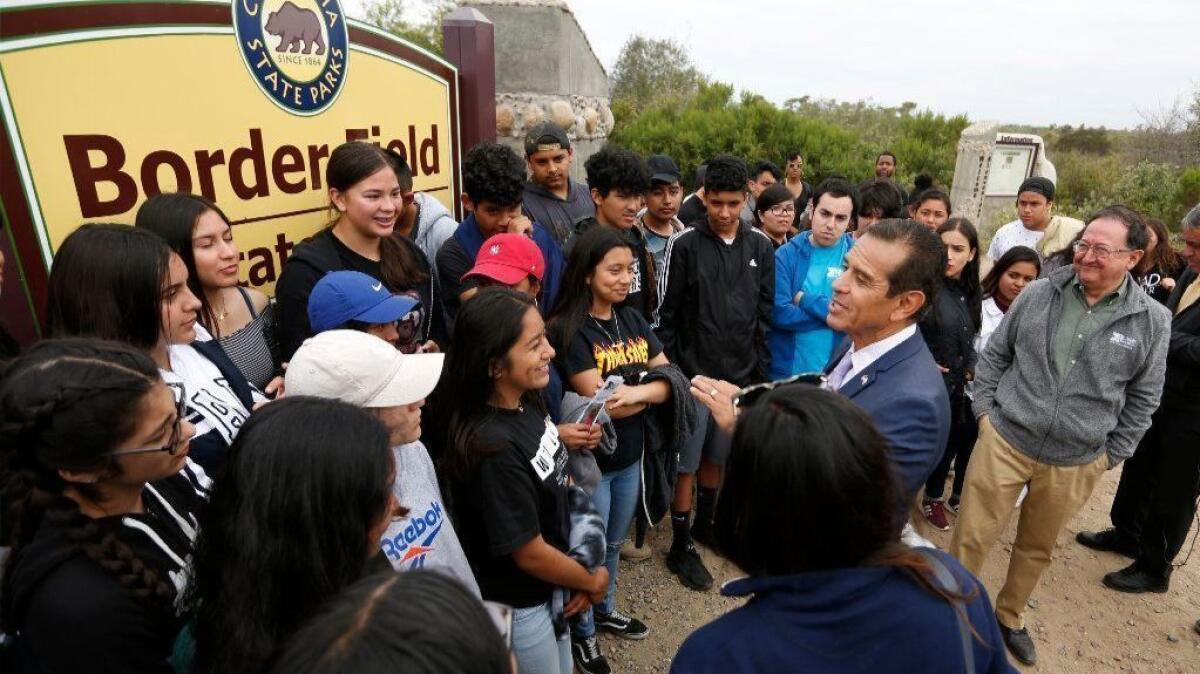
Immigration
Allen: Allen, who has staked his candidacy on his support for President Trump’s policies, has voiced the strongest opposition to California’s immigration policies, including the so-called “sanctuary state” law, which limits cooperation between state and local law enforcement officials and federal immigration authorities.
He was one of the most vocal politicians in his call on Trump and U.S. Atty. Gen. Jeff Sessions to sue California over the state’s immigration policies, and also urged the Trump administration to prosecute California Atty. Gen. Xavier Becerra for warning businesses that he would seek fines if they violate a state law that prohibits them from voluntarily giving employee information to federal immigration authorities.
Allen is opposed to the state providing benefits such as Medi-Cal to immigrants in the U.S. illegally.
Chiang: Chiang supports California’s sanctuary state law, and has spoken out against the Justice Department’s legal challenge of the state’s immigration policies.
He has said the state must take an active role in fighting the Trump administration on the issue.
Cox: Like fellow Republican Allen, Cox has been steadfast in his opposition to California’s immigration policies. He has promised to rid the state of the sanctuary state law if elected governor.
Shortly after the Trump administration sued California over its immigration laws, Cox released a minute-long radio ad seeking to tie sanctuary policies to the death of Kate Steinle, a young woman who was killed in San Francisco in July 2015.
Eastin: Eastin strongly supports California’s sanctuary state law, and says she “would act to make sure that our undocumented (and documented) workers are protected from the predatory behaviors we have witnessed the federal government take.”
Newsom: Newsom also is a strong supporter of California’s sanctuary state law. As San Francisco mayor, he presided over a city with sanctuary policies.
He has often taken to Twitter to condemn Trump’s immigration policies, slamming the president’s plan to build a wall at the U.S.-Mexico border.
“We cannot let this small, scared bully hurt our economy and turn ICE into his own personal army of hate,” Newsom said in a March 13 tweet.
Villaraigosa: Immigration has been a signature campaign issue for Villaraigosa, who strongly supports California’s sanctuary state law. Like San Francisco, Los Angeles had sanctuary policies in place when Villaraigosa was mayor.
At a recent campaign event, Villaraigosa was critical of a Trump administration policy to separate children from their parents when a family crosses the border illegally.
“We are not a nation that divides mother from daughter, father from son, family from parents,” Villaraigosa said. “We’re better than that.”
Everything you need to know about the June 5 primary »
Coverage of California politics »
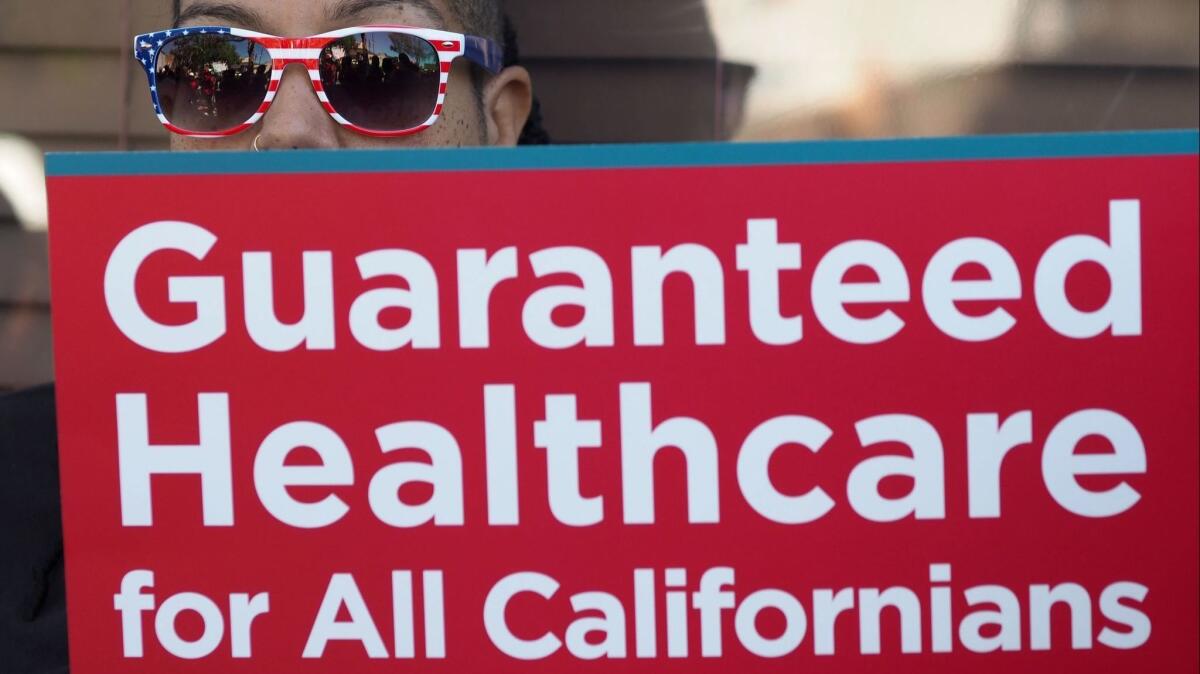
Single-payer healthcare
Allen: Allen is staunchly opposed to a state single-payer healthcare system. He has said single payer would be as efficient and customer-friendly as the DMV and bankrupt the state.
Chiang: Chiang has urged caution on single-payer healthcare. Instead of transforming healthcare in California in one fell swoop, the state should implement such a program bit by bit to ensure that it's affordable and effective, he said.
"I support single payer, but we have to be truthful here," Chiang said during a fall Democratic debate in San Francisco. "How many of you want to pay an additional 90% in taxes? … Let's scale up, see what revenues we have, because we can't cover everything."
Cox: Cox is opposed to implementing a state-run single-payer healthcare system. He has mockingly suggested that the state could also provide "single-payer food and single-payer housing" for everyone.
In a 2017 opinion piece for the Orange County Register, titled “Health care for all? More like how to destroy California,” Cox said the only way implementing state-sponsored universal healthcare could work “is to drastically cut payments to hospitals, doctors and drug companies — or put the doctors, nurses and hospitals on the state payroll, which will drive many of our doctors to pack up and leave.”
Eastin: Eastin has touted her stance as a “staunch, unwavering supporter of SB 562,” the California single-payer healthcare bill proposed last year by state Sen. Ricardo Lara (D-Bell Gardens) and now state Senate President Pro Tem Toni Atkins. The legislation was shelved in the Assembly over concerns about the cost and the lack of a comprehensive plan of how to pay for and implement the program.
Eastin says on her campaign website that she believes such a system could be funded through “some combination of new taxes, such as the proposed gross receipts tax on business income over $2 million, combined with a sales tax increase.” She also supports creating a Public Bank of California to help fund universal healthcare.
Newsom: Newsom has promised to pursue a state-supported single-payer healthcare system if he's elected in November, but like Eastin has not outlined a clear plan to fund such a program. Achieving universal healthcare in California has been a central part of his campaign.
His support for SB 562 has been enthusiastic, but has also been nuanced. He has been endorsed by the California Nurses Assn., the most vocal backer of the bill, but has acknowledged there are some "open-ended" issues with the legislation. He has also voiced support for an effort by a coalition of labor unions, community health organizations and immigrant-rights groups to steer the healthcare debate away from SB 562.
Villaraigosa: Villaraigosa has expressed qualified support for single-payer healthcare, but has emphasized his skepticism over the state’s ability to finance such an undertaking. He has been particularly critical of Newsom's campaign promise to put a universal healthcare program in place, saying it would require all Californians on Medicare to give it up in favor of a new, unproven state-run system.
“Newsom calls any attempt to demand details of his $200-billion tax increase and plan to force seniors off of Medicare as 'defeatist,'" Villaraigosa has said. "I call refusing to say how you will successfully persuade Californians to more than double their taxes while taking away their Medicare simply deceptive."
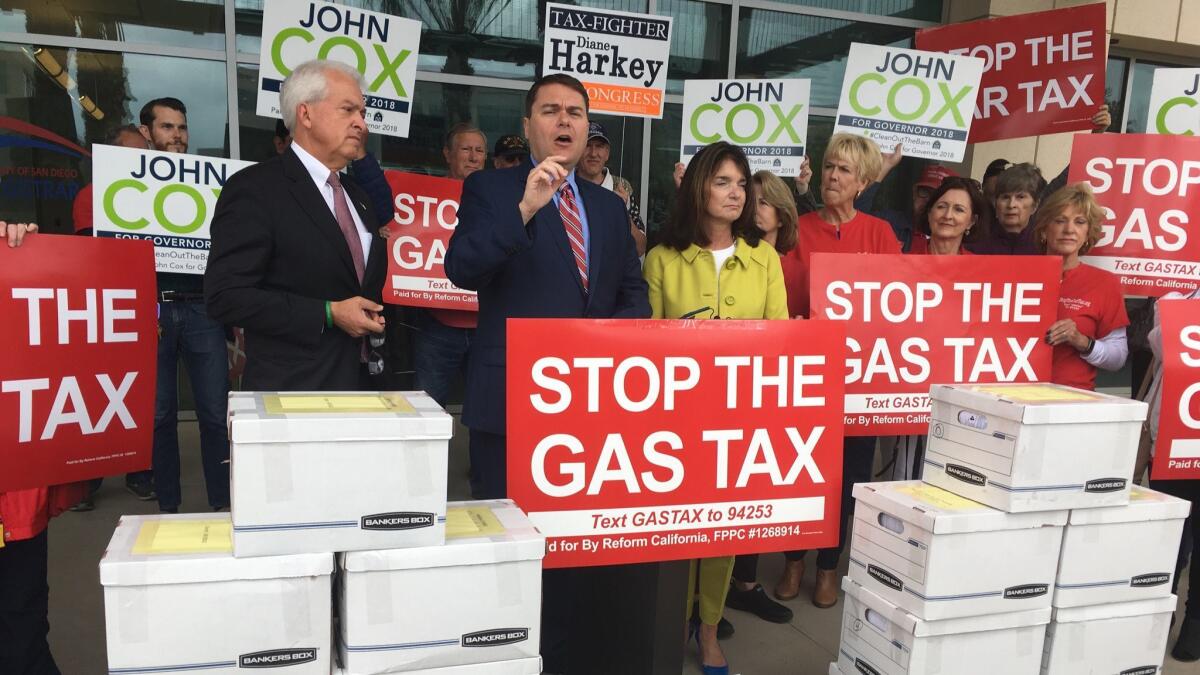
Transportation and infrastructure
Allen: Opposition of the state’s increased gas tax and vehicles fees has been a primary vehicle of Allen’s campaign. Last year, Gov. Jerry Brown signed into law a 12-cents-per-gallon increase in the gas tax, a 20-cent increase in the diesel fuel excise tax and a new annual vehicle fee ranging from $25 for cars valued at under $5,000, to $175 for cars worth $60,000 or more.
Allen tried and failed to qualify a ballot measure to put a repeal of the gas tax before voters, and has since agreed to lend his support to a competing measure championed by his opponent, Cox. He has emphasized that he believes the state already has the available revenue needed to improve California’s crumbling transportation infrastructure.
If elected governor, Allen has said he would immediately move to kill Gov. Jerry Brown’s $77-billion high-speed rail project. He opposes the state’s WaterFix program to build twin tunnels in the California delta.
Chiang: Chiang supports the state’s increased gas tax and vehicle fees.
“If you have a leaky roof, you have to repair that roof,” Chiang told NBC’s Chuck Todd at a recent debate. “You don’t want greater damage.”
Chiang has also advocated for using the green bond market to fund environmentally friendly transportation projects, saying on his campaign website that it would “unleash a torrent of new, affordable capital to finance the conversion from a fossil-fuel based economy and infrastructure to cleaner alternatives.”
Chiang supports high-speed rail. He has been measured in his support for the delta tunnels, saying that the state “must first ensure that we are doing everything possible to protect our ecosystems, our water supply and our economy.”
Cox: Like Allen, Cox has been a fierce opponent of the state’s increased gas tax and vehicle fees.
He has joined the California Republican Party and top Republicans including House Majority Leader Kevin McCarthy of Bakersfield in donating hundreds of thousands of dollars to "Give Voters a Voice," a campaign committee behind a repeal measure expected to qualify for the November ballot. Cox, a wealthy Rancho Santa Fe businessman, donated $250,000 to the effort.
Cox has been a vocal opponent of high-speed rail, and launched an ad criticizing Villaraigosa for his support of the project. He has said he would work to kill it. He opposes the state’s delta tunnels project.
Eastin: Eastin supports the gas tax and is opposed to repealing it. She has frequently focused on the need to repair the state’s ailing system of highways, saying on her campaign website that California “cannot keep borrowing money to build shiny new projects without first fixing what we already have.”
She has been somewhat reluctant to support high-speed rail, saying that she isn’t a fan of using general obligation bonds to pay for the project. She has suggested an oil severance tax to pay for the bullet train’s high cost.
Eastin has also advocated for providing public broadband to underserved communities. She has criticized the state for its water planning, and opposes the delta tunnels plan, calling it an “old idea.”
Newsom: Like each of his top Democratic opponents, Newsom supports the state’s increased gas tax and vehicle fees.
“We need to protect and preserve the gas tax,” Newsom told NBC’s Todd at a May 8 debate. “There’s 52 billion reasons why we need to do it.”
Newsom has been accused of flip-flopping on high-speed rail, but has said he wants to keep the project going.
On other infrastructure projects, the lieutenant governor has said he strongly backed the $7.5-billion water bond approved by voters in 2014, including $2.7 billion for water storage.
He has expressed qualified support for Brown’s delta tunnels project, telling Times columnist George Skelton that "there is room for cooperation and compromise around a single tunnel.” In May, $11 million was committed to build two massive tunnels to convey water under the Sacramento-San Joaquin Delta to the San Joaquin Valley and then on to the Southland.
Villaraigosa: As Los Angeles mayor, Villaraigosa made transportation a focus of his tenure, pushing for a ballot measure to fund an ambitious “Subway to the Sea” project.
But Villaraigosa has been slightly more tentative in his support for the gas tax than the other Democrats in the race. He has urged caution in raising taxes for how it might impact lower-income families, telling the Orange County Register, “We can’t just keep on raising taxes to pay for infrastructure.”
On the bullet train, Villaraigosa told The Times that he would find private investors to plug the funding gap. He wants to streamline permitting and find ways to cut costs.
Villaraigosa has also been reluctant to support the twin tunnels project, saying through a spokesperson that other options could be pursued.
"Have we done enough to conserve? Are we using the latest technologies to refresh our underground aquifers? Are we moving forward with all appropriate speed in building new storage to capture water during rainy years? Are we capturing and cleaning urban runoff? Are cities recycling water as much and as well as they can? We need to adequately answer those questions first."
Times staff members Liam Dillon, Melanie Mason, Patrick McGreevy, Seema Mehta, George Skelton, Ralph Vartabedian and Allison Wisk contributed to this report.
Get the L.A. Times Politics newsletter
Deeply reported insights into legislation, politics and policy from Sacramento, Washington and beyond. In your inbox three times per week.
You may occasionally receive promotional content from the Los Angeles Times.







